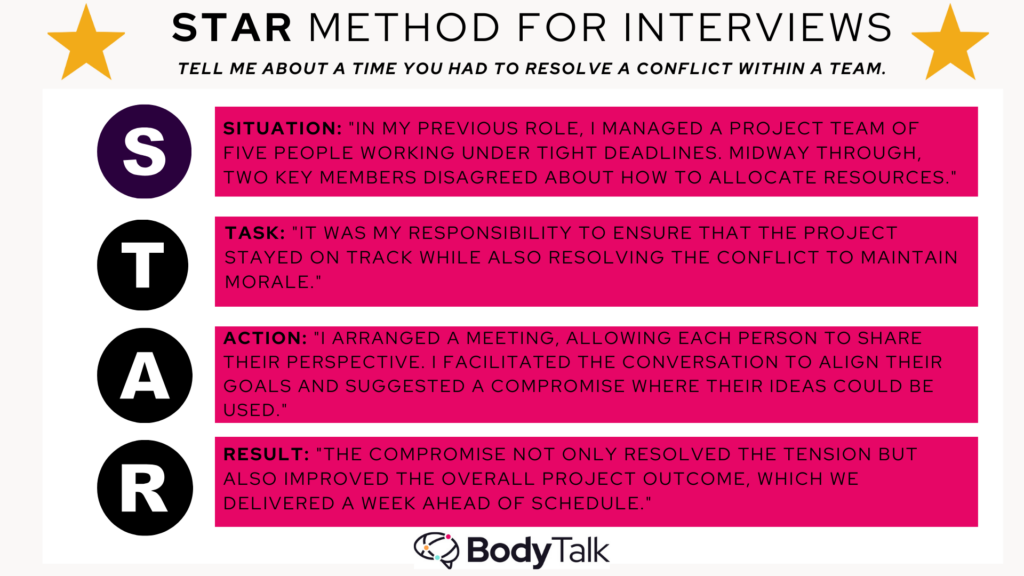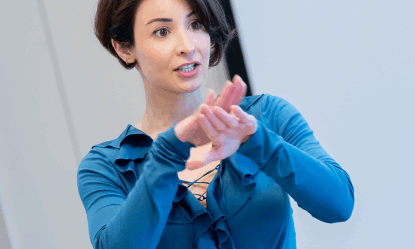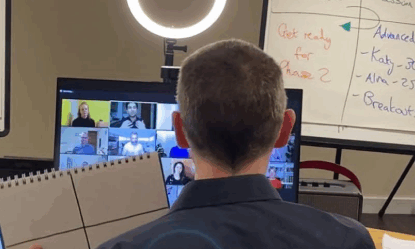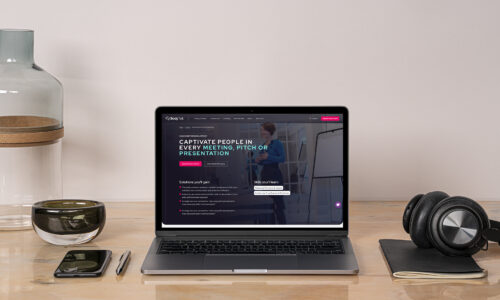You’ve landed the interview, great! But as the big day approaches, doubt creeps in. You walk into the interview room or log into the Teams call. Your heart pounds in your chest, your hands feel clammy, and you’re struggling to catch your breath. What if I forget what to say? What if they ask something I’m not prepared for? How do I make a lasting impression? Will I say too much… or not enough?
Interviews are nerve-wracking and if that wasn’t enough, The British Psychological Society says research shows that interviewers tend to rate nervous candidates more harshly.
These reactions are not just in your head, they’re your body’s natural response to stress. When you’re faced with the pressure of a job interview, your brain triggers a “fight, flight, or freeze” response, designed to help you react to high-stakes situations. Unfortunately, this survival mechanism isn’t ideal when you’re trying to think on your feet and present yourself as the perfect candidate.
As adrenaline and cortisol flood your system, your heart races, pumping more oxygen to your muscles in case you need to act quickly. But instead of helping you sprint from danger, this racing heart can leave you feeling jittery. Meanwhile, your palms grow damp, your mouth dries up, and your thoughts race, making it harder to remember the carefully prepared answers you practised just the night before.
You know you need to stand out, but in a sea of candidates, how do you showcase not just what you know but who you are?
This is where your presentation skills come into play. Interviews aren’t just about answering questions, they’re about how you communicate, connect, and convince the interviewer that you’re the perfect fit. How you tell your story, deliver your message, handle those unexpected curveball questions and manage your nerves can determine your success.
In this blog, we’ll explore practical ways to demonstrate your presentation skills in an interview, so you’ll feel ready to present your best self with clarity and confidence.
Understanding the Importance of Presentation Skills
Presentation skills aren’t just reserved for formal speeches or PowerPoint slides, they’re essential in job interviews too. Why? Because interviews are about more than just technical skills. Employers are looking for candidates who can communicate their ideas effectively, and connect with others. How you speak, structure your answers, and present yourself gives interviewers insight into your ability to engage with future colleagues, clients, or stakeholders. A candidate with strong presentation skills demonstrates confidence, clarity, and the ability to influence; qualities essential for most roles, especially leadership or client-facing positions.
Your goal in an interview isn’t just to answer questions, it’s to tell a story about who you are, what you can do, and why you’re the best fit for the job.
Master the Art of Storytelling
Storytelling transforms your answers from ordinary to impactful. Interviewers don’t just want a list of responsibilities from your past roles, they want to know how you applied your skills, overcame challenges, and achieved results.
A great way to structure your responses is by using the STAR method which is used widely in organisations from the police to the BBC.
The STAR method—Situation, Task, Action, and Result—is a powerful framework for structuring answers in interviews, especially when discussing past experiences. It transforms a simple list of tasks into compelling narratives that highlight your problem-solving abilities, decision-making, and the value you bring to a role.
- Situation: Sets the context and makes your story relatable.
- Task: Clarifies your responsibility or goal, demonstrating ownership.
- Action: Shows your approach and decision-making, highlighting key skills.
- Result: Reflects the value or outcome, showcasing the tangible impact you achieved.
Here’s an example of how to use STAR:
Question: Tell me about a time you had to resolve a conflict within a team.
- Situation: “In my previous role, I managed a project team of five people working under tight deadlines. Midway through, two key members disagreed about how to allocate resources.”
(This sets the stage, showing the complexity of the situation and demonstrating that team dynamics were at risk). - Task: “It was my responsibility to ensure that the project stayed on track while also resolving the conflict to maintain morale.”
(You highlight your ownership of the problem and your accountability for the outcome). - Action: “I brought the two individuals together for a meeting, allowing each to share their perspective. I then facilitated a conversation to align their goals and suggested a compromise where each could implement part of their ideas.”
(This demonstrates your leadership, conflict resolution skills, and ability to collaborate). - Result: “The compromise not only resolved the tension but also improved the overall project outcome, which we delivered a week ahead of schedule.”
(You close with quantifiable success, proving your effectiveness in managing conflict while meeting deadlines).

Using STAR to structure your narrative helps the story stick in the interviewer’s mind and demonstrate not just what you’ve done but how you think, solve problems, and create value. With each answer, you’re painting a picture of what it would be like to work with you, and helping the interviewer imagine you in the role.
Present with Confidence
Your delivery matters as much as your content. Even the best-prepared answers can fall flat if delivered in a rushed, monotone, or hesitant manner. Here’s how to exude confidence:
- Pace Yourself: Speak slowly and clearly. Nerves can make you rush, but intentional pacing shows that you’re in control.
- Use Body Language Effectively: Sit upright with a lifted sternum, make eye contact, and use natural gestures. Open, relaxed body language communicates that you’re approachable and prepared.
- Smile: It’s a small thing, but smiling can release tension and create rapport with your interviewer. It also sends a positive signal to your brain, helping you feel more relaxed.
- Embrace Pauses: A short pause before answering a question gives you time to think and makes you appear thoughtful and composed. It can also help prevent filler words like “um” or “like.”
Confidence isn’t about being perfect, it’s about being present. When you slow down, breathe, and trust yourself, you’ll deliver your message with authenticity and impact.
Handle Nerves
It’s normal to feel nervous before or during an interview. Instead of trying to eliminate nerves, learn to manage them so they don’t take control. Here are a few techniques:
- Be mindful of your breathing: Take slow, deep breaths to reduce your heart rate and relax your muscles. Focus on the exhale first, when we focus too much on inhaling, we risk over-breathing, which can lead to dizziness and lightheadedness. By fully exhaling, you make room for a deeper, more effective inhale which helps oxygen circulate more efficiently and helps shift you into a calmer state.
- Ground Yourself: If you feel overwhelmed, focus on something physical, the floor under your feet or the sensation of your hands resting in your lap. This brings your mind back to the present moment.
- Reframe Your Nerves as Excitement: If your heart is racing, tell yourself it’s because you care and are ready to perform well. This shift in mindset can help you turn nervous energy into enthusiasm.
- Visualise Success: Picture yourself answering questions confidently, connecting with the interviewer, and leaving a positive impression.
Nerves aren’t the enemy, how you respond to them is what matters. Learning to ride the wave of anxiety rather than resisting it will keep you grounded and clear-headed throughout the interview.
Tips for Interviewing on Zoom or Teams
With remote interviews becoming increasingly common, knowing how to present yourself effectively in a virtual setting is crucial. Here are some tips to ensure a successful Zoom or Teams interview:
- Test Your Technology: Before the interview, check that your camera, microphone, and internet connection are working properly. Familiarise yourself with the platform features, like screen sharing or chat functions.
- Choose an Appropriate Background: Select a quiet, well-lit space for your interview. A clean, neutral background keeps the focus on you while distracting backgrounds can divert attention away from your message.
- Engage with the Camera: Make eye contact by looking at the camera instead of the screen. This helps build a connection with your interviewer, making your communication feel more personal.
- Be Mindful of Non-Verbal Cues: Just like in an in-person interview, body language matters in virtual settings. Sit up straight, be aware of how your gestures fit within the frame of your video screen, and nod to show you’re engaged.

Handling Curveball Questions with Confidence
Curveball questions—those unexpected, challenging queries—can catch even the most prepared candidates off guard. Whether it’s a strange hypothetical like “How many tennis balls fit into a Boeing 747?” or a probing behavioural question such as “Tell me about a time you failed,” these questions are designed to see how you think on your feet and respond under pressure.
Here’s how to handle them with confidence:
1. Pause and Breathe
When a curveball question is thrown your way, your first instinct might be to rush into an answer. But permitting yourself to pause can make all the difference. A brief moment to breathe not only calms your nerves but also shows the interviewer you’re thoughtful and composed. Pausing sends the message: I’m not rattled, I’m considering my response.
2. Think Out Loud
Curveball questions often test your problem-solving process rather than your knowledge. If the question is abstract—like the Boeing 747 example—don’t worry about finding the perfect answer. Instead, explain your thought process aloud. For instance, you might say:
“Well, I’d start by estimating the size of the plane’s cargo area and the volume of a tennis ball. Then, I’d factor in how efficiently they could be packed… It’s not an exact science, but it gives me a framework to work with.”
This demonstrates that you can approach problems logically and systematically, even when caught off guard.
3. Stay Positive, Especially with Behavioral Questions
Some curveballs might dig into uncomfortable territory, like “What’s your biggest weakness?” or “Tell me about a time you made a mistake.” The key here is honesty combined with a growth mindset. Choose an example where you’ve learned from the experience, and emphasise the steps you took to improve.
For instance:
“In my previous role, I underestimated the time needed for a project, which led to delays. I took responsibility, communicated the situation early, and adjusted my time-management approach to prevent it from happening again. Since then, I’ve delivered all my projects on time.”
This approach turns a potential negative into a story of growth and resilience.
4. Link your response to the qualities they’re looking for
When asked, “If you were an animal, what would you be?” it might seem like a bizarre question with no right answer. But here’s the catch, it’s not about the animal itself. Interviewers use questions like this to uncover qualities and traits that align with the role. Your answer gives them insight into your personality, work style, and how well you fit within the company’s culture.
The key is to use the animal to showcase the qualities they’re seeking for the role. For example:
- If they need a team player:
“I’d be a dolphin because they communicate well, work in teams, and support each other to achieve goals.” - For a leadership position:
“I’d be an eagle. They have incredible eyesight and can see everything but choose their moments carefully and generally stay back.” - If creativity or agility is important:
“I’d be a cat. Adaptable, curious, and able to think quickly on my feet.”
Tailoring Your Answer to the Role
Before your interview, reflect on the qualities that the company values. Does the role require collaboration, strategic thinking, or problem-solving? Pick an animal that embodies those traits and tie it back to the job requirements.
For example, if applying for a sales role, you might say:
“I’d be a cheetah. Able to move fast and stay focused on my target, but also knowing when to pause and conserve energy.”
It’s also helpful to acknowledge how the qualities of your chosen animal reflect your strengths in real life. For example:
“I chose the cheetah because in my previous role, I thrived in fast-paced environments, balancing urgency with precision.”
Curveball questions like this aren’t meant to throw you off—they’re an opportunity to reveal the qualities that make you a great fit for the role. The trick is to think beyond the animal and focus on the traits you want the interviewer to see in you.
5. Show Poise Under Pressure
The real test of a curveball question isn’t just what you say, it’s how you say it. Even if you stumble slightly, staying calm and composed will leave a better impression than rushing or appearing flustered. Remember, interviewers aren’t looking for perfection; they’re looking for someone who can think clearly under pressure and bounce back from challenges.
Curveball questions can be intimidating, but they’re also an opportunity to showcase your ability to stay composed, think critically, and communicate clearly. When you approach them with curiosity and a sense of calm, you demonstrate the qualities employers value most; resilience, adaptability, and confidence.
If you’re unsure about the question, it’s okay to ask for clarification. For example:
“Could you elaborate on what you mean by that?”
This buys you a little time and shows you’re committed to understanding the question fully before responding.
Final Thoughts
Presentation skills are about more than standing in front of a room, they’re about how you communicate, connect, and inspire others. Interviews give you a chance to present your best self, not just through words but how you deliver them. By mastering storytelling, handling nerves, and exuding confidence, you can transform your interview into an opportunity to showcase both your skills and your personality.
Whether in person or online, each interaction is an opportunity to show the interviewer that you are more than just a candidate, you are the solution to their problem. When you combine thoughtful preparation with clear, confident communication, you’ll leave a lasting impression and take one step closer to landing the role you’ve been working toward. Good luck!


















